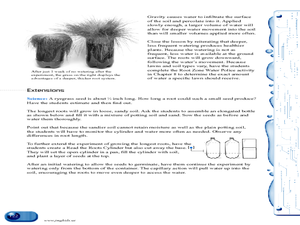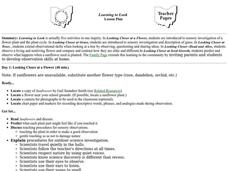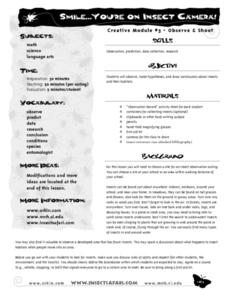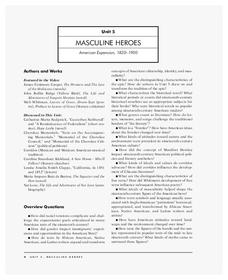Curated OER
Leaves of Grass by Walt Whitman
In this online interactive reading comprehension learning exercise, students respond to 12 multiple choice questions about Whitman's Leaves of Grass. Students may submit their answers to be scored.
Curated OER
Life, Death, Dirt, & Walt Whitman
Walt Whitman was a composter? Certainly the cycle of life and death he describes in "Leaves of Grass" parallels the processes going on in a compose pile. The interdisciplinary approach detailed here could be used to foster a deeper...
Curated OER
"ART ZOO 'Blacks in the Westward Movement', 'What Can You Do with a Portrait', and 'Of Beetles, Worms, and Leaves of Grass'"
Students study black history, examine portraits and portrait making and create their own portraits, and investigate their natural environment. This humanities lesson provides a text that can be used to teach lessons in black history,...
Curated OER
Growing a Lawn
Students research plant growth. In this plant growth lesson, students explore the needs of plants. Students compare and contrast grass and broadleaf plants and grow a miniature lawn in a cup of soil. Resources are provided.
Curated OER
Read The Roots
Students experiment to determine the best watering schedule to use when growing grass. In this grass watering instructional activity, students examine rye grass seeds and discuss the role roots play in keeping grass healthy. They grow...
Curated OER
Camouflage
Here is a lesson which incorporates ingenious hands-on activities that simulate how many animals use camouflage as a survival technique. This lesson clearly outlines how to implement the activities and discussion sessions found in it....
Curated OER
Learning To Look
Sixth graders investigate a flower plant and the plant cycle. They extend observational skills when looking at a tree by observing, questioning and sharing ideas. They observe a living and nonliving flower and compare and contrast how...
Curated OER
Very, Very, Simple Decorative Papers
Elementary schoolers gather flowers, leaves, fiber, ribbons and newspapers to expand studenT awareness of their environment. They use these to make printmaking papers, cards, book covers, picture frames and photo mats. Beautiful results...
Curated OER
Fall Perspective Landscape
Fall can be a beautiful time of year with leaves and bright colors everywhere! Little ones can explore the wonders of fall as they create perspective landscapes showing a fall scene. They work on creating a foreground, background and...
ELI Publishing
Whitman and the American ‘Romantic’ Nature
Pupils read a short biography of Walt Whitman and a portion of Whitman's epic poem "Song of Myself." Readers then respond to a series of comprehension questions.
Curated OER
Pen and Ink Drawing
Learners hone their drawing techniques to create a nature-inspired piece of art. They practice hatching, cross hatching, stippling, and shading. They discuss how each method is better suited for creating specific elements in nature such...
Curated OER
Playground Greenup
Students document changes in the playground vegetation during the year by making drawings or taking digital photographs of grass, trees, bushes, weeds, and other vegetation. They study how the color of vegetation changes during different...
Curated OER
Feeling the Heat
Students investigate the urban heat island effect. In this urban heat island effect lesson, students learn how trees, grass, asphalt, and other things on the school grounds effect temperature. They use the information to generalize it to...
Curated OER
Smile...you're on Insect Camera!
Learners study insects. They go on an outdoor insect outing and look for insects in a variety of places--in the air, under rocks, on leaves, in water, etc. They record information about the insects they find, including habitat, weather...
Curated OER
Plant a Seed of Kindness
Students perform acts of kindness. In this character instructional activity, students cut out seed shapes and write down their acts of kindness on them. Students place the seeds on a bulletin board where they "plant" them below the...
Curated OER
Building An African Compound
Students construct a model of an African compound. In this African culture lesson, students describe the neighborhoods that can be found in Africa. Students use construction paper, glue, dried leaves, and a cardboard box to construct a...
Curated OER
Gullah Contributions to South Carolina History
Students research the Gullah people and their impact on South Carolina. In this South Carolina history lesson, students study, locate, and color the region of Africa the Gullah people came from. Students listen to Gullah music and watch...
Chicago Botanic Garden
Preparing for Project BudBurst
Male deer growing antlers to begin the breeding season is an example of a phenological event. First in a four-part series is an activity requiring individuals to collect phenological data on their campus. Classes discuss phenology, the...
Polar Trec
Permafrost Thaw Depth and Ground Cover
The thaw depth of tundra creates a positive feedback loop with both global warming and the carbon cycle. Scholars sort photos and develop a hypothesis for ground cover and permafrost depth. Then they review the data and measurements...
Curated OER
Adaptations to Environments with Mammals
Fifth graders, after viewing a PowerPoint on different mammals, analyze what a biome is. Then they choose a mammal to research and go outside to feel the grass and leaves and hypothesize about which biome they live in as well as its...
Annenberg Foundation
Masculine Heroes
What were the driving forces behind American expansion in the nineteenth century, and what were its effects? Scholars watch a video, read biographies, engage in discussion, write journals and poetry, draw, and create a multimedia...
Outdoor Learning Center
Outdoor Survival
Which of the following can you survive without for the longest time: water, food, or a positive mental attitude? The answer may surprise you. Guide learners of all ages through games, activities, and discussions about surviving in the...
Curated OER
An Interdisciplinary Approach to Learning with Walt Whitman
Use poetry as a mode for creating interest and cross discipline learning.
Advocates for Human Rights
Who are Immigrants?
What do Jerry Yang, Patrick Ewing, John Muir, Charlize Theron, Peter Jennings, and Saint Frances X Cabrini all have in common? They are all immigrants to the United States. Famous and not-so-famous immigrants are the focus of a resource...

























